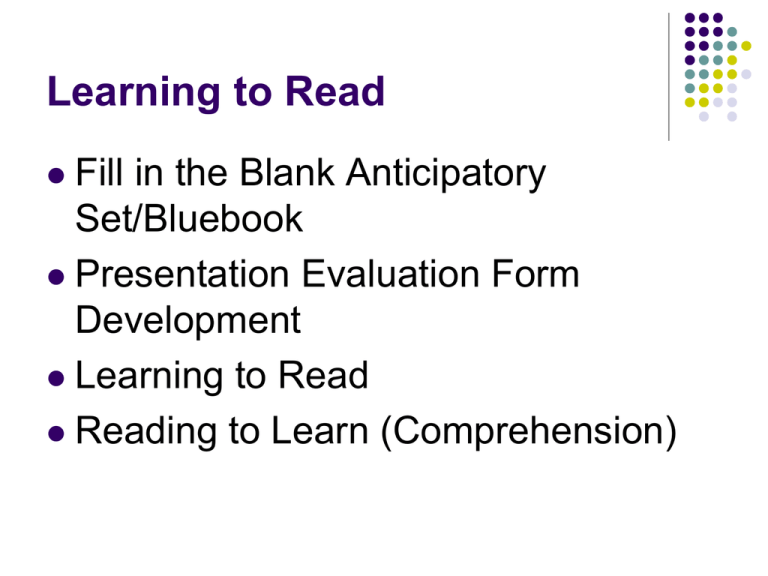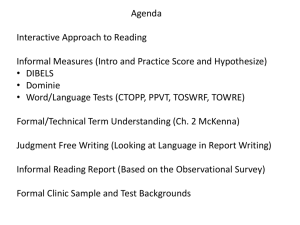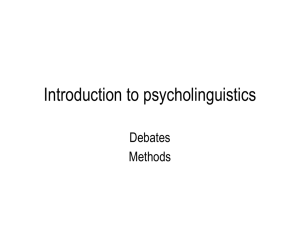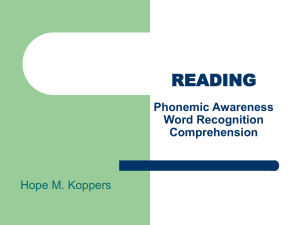Learning to Read for Comprehension
advertisement

Learning to Read Fill in the Blank Anticipatory Set/Bluebook Presentation Evaluation Form Development Learning to Read Reading to Learn (Comprehension) Relationship between Schooling and Income U.S. Bureau of the Census, 2000 "CHILDREN ARE MADE READERS ON THE LAPS OF THEIR PARENTS.“ — EMILIE BUCHWALD Outcomes of Early Exposure Number 1 predictor of success in school is how much a child is read to prior to entering Kindergarten Age 7 reading ability predicts school achievement in High School Literacy Learning to Read Reading Fluency (Ch 2) Early Literacy: Concepts of Print Phonemic Awareness Decoding skills Accessing word meaning Sentence Integration Reading to Learn Reading Comprehension (Ch 3) Prior knowledge Inference making Comprehension monitoring Literacy: Learning to Read Reading Fluency Acquiring skills "Babies are born with the instinct to speak, the way spiders are born with the instinct to spin webs. You don't need to train babies to speak; they just do. But reading is different." — Steven Pinker Early Literacy in the Home Lists Entertainment School-related tasks Sunday activities Communication Story Time Shopping, Things to Do Magazines, TV guide, Rules for Games Sibling homework, playing school Bible reading, Sunday school activities Letters, notes, messages, holiday cards Children’s books, pre-reading Learning to Read Prereading: Must realize that there is a correspondence between printed page and spoken language “Concepts of Print” Phonemic awareness: Must establish letter-sound correspondences English has 26 letters, but 42 basic phonemes Learning to Read Prereading: Must realize that there is a correspondence between printed page and spoken language Phonemic awareness: Must establish letter-sound correspondences “Concepts of Print” English has 26 letters, but 42 basic phonemes Decoding: Must realize that a printed word corresponds to specific combination of sounds Bottom-Up vs. Top-Down Bottom-up: start with the basic units and build up Bottom-up models operate on the principle that the written text is hierarchically organized (i.e., on the grapho-phonic, phonemic, syllabic, morphemic, word, and sentence levels) and that the reader first processes the smallest linguistic unit, gradually compiling the smaller units to decipher and comprehend the higher units (e.g., sentence syntax).” (Dechant 1991) letters units of sound words phrases sentences etc. Emphasizes “word-attack skills”, use texts that emphasize phonemic analysis… Bottom-Up vs. Top-Down Bottom-up: basic units and build up Phonics first letters units of sound words phrases sentences etc. Emphasizes “word-attack skills”, use texts that emphasize phonemic analysis… Top-down: proceeds from information already stored in memory (prior knowledge) to decipher unit level input Using meaning and syntax to figure out unfamiliar words Whole language: meaning first Emphasizes many rich opportunities to experience written language (e.g., authentic literature, song) Learning to Read Prereading: Must realize that there is a correspondence between printed page and spoken language Phonemic awareness: Must establish letter-sound correspondences “Concepts of Print” English has 26 letters, but 42 basic phonemes Decoding: Must realize that a printed word corresponds to specific combination of sounds Meaning Making: Must understand what they read Semantic and syntactic knowledge Reading: A Challenging Task I’m trying hard to learn to read But what’s a kid to do When there’s a NO and a GO and a SO and a HO And then there’s a word like TO? Reading BONE and CONE and LONE and TONE Can almost be kind of fun. But I get upset when I have to believe That D-O-N-E spells DONE! It’s plain to see a kid like me Sure needs a helping hand. No matter how much I really try, I just don’t understand I’m trying hard to learn to read Somehow that’s what I’ll do. But for now if you’ll just read to me, Someday I’ll read to you. Tomorrow was the annual, one-day fishing contest and fisherman would invade the place. Some of the best bass guitarists in the country would came to this spot. The actress received praise for being an outstanding _______. performer Jack and Jill ran up the ______. stairs Happy _______! Holidays! Be my _________ . Avocado Study Results Time to read in milliseconds (Tulving & Gold, 1963) 100 90 80 70 Inappropriate Appropriate 60 50 40 30 1 2 4 number of context words 8 Bottom-Up vs. Top-Down Bottom-up: basic units and build up Phonics first letters units of sound words phrases sentences etc. Emphasizes “word-attack skills”, use texts that emphasize phonemic analysis… Top-down: proceeds from information already stored in memory (prior knowledge) to decipher unit level input Whole language: meaning first Emphasizes many rich opportunities to experience written language (e.g., authentic literature, song) Main issue: How to combine these two processes effectively Learning to Read Prereading: Must realize that there is a correspondence between printed page and spoken language Phonemic awareness: Must establish letter-sound correspondences English has 26 letters, but 42 basic phonemes Decoding: Must realize that a printed word corresponds to specific combination of sounds Meaning Making: Must understand what they read “Concepts of Print” Semantic and syntactic knowledge Sentence Integration: Automaticity The key to effective reading is automaticity The more automatic our reading and recognizing words, the less space taken in working memory. Then the mind can spend more time on meaning and context, as well as making inferences about the text or passage, leading to comprehension Scaffolding the Beginning Reader How do we help students obtain automaticity? Assess first (running record) Teach students to attend to cues by prompting Mediators in the form of spoken language Phonics- “get your mouth ready” or “sound it out” Semantic- “what makes sense” or “look at the picture” Syntactic- “skip it, read on and then go back” or “go back and reread” “Once you learn to read, you will be forever free.” -Frederick Douglas Literacy: reading to Learn Reading Comprehension Academic Outcomes Learning Perception-Knowledge Cycle • Many view learning as a bottom-up process; starting from the basic unit of perception and building upon it The Perception-Knowledge Cycle top up Knowledge (memory) • Efficient learning requires extensive use of top-down processing or the use existing knowledge to facilitate new learning (expectations, aims, goals) Perception bottom down Reading to Learn Prior Knowledge: Influences what is remembered (learned) Priming exercise Memory Demonstration Perceptual Priming as Expectation Bias Study Test Expectations can influence what you perceive! Reading to Learn Prior Knowledge: Influences what is remembered (learned) Priming exercise Topic Priming Topic Priming: Title of Text Comprehension and Recall Scores for the Passage No Topic Topic After Topic Before Maximum Score Comprehension ratings 2.29 2.12 4.50 7.00 Number of Idea Units recalled 2.82 2.65 5.83 18.00 Bransford and Johnson (1972) Learning Perception-Knowledge Cycle • Problem: Most view learning as a “bottom-up” process • Efficient learning requires extensive use of top-down processing (expectations, aims, goals) The Perception-Knowledge Cycle up Conceptual Learning Knowledge (memory) top • Involves the interplay between bottom-up and top-down processing • Knowing what you expect to learn (goals, aims) will facilitate learning. Perception bottom down Using Prior Knowledge Using prior knowledge provides us with context and meaning while we are reading. Background knowledge is imperative to effective learning. Class discussions and activity increases comprehension. If we have no prior knowledge to “hook” our new information into, we will be challenged to understand, comprehend, or learn. What people know influences what they will remember about a passage Therefore, we must provide background knowledge. •Make sure it is appropriate •Make sure it is interesting •At grade level Reading to Learn Prior Knowledge: Influences what is remembered (learned) Priming exercise Topic Priming Inference Making: Drawing conclusions beyond the text Background Knowledge Making Inferences This is the cornerstone of reading comprehension Keys: This skill improves as children develop It improves with TRAINING and assisted performance Teach students to begin to generate their own questions about a passage It helps for them to practice and explain how inferences are made [Gregory, A. & Cahill, M.A.(2010) K-schema, connections, visualize, ask questions, infer] Reading to Learn Prior Knowledge: Influences what is remembered (learned) Inference Making: Drawing conclusions beyond the text Priming exercise Topic Priming Background Knowledge Comprehension Monitoring: Teach strategies Reading and Vocabulary Development Content Rare words/1000 Comic Books 53.5 Children’s Books 30.9 Preschool Books 16.3 Prime-time Adult TV Prime-time Children’s TV 22.7 20.2 Conversation College Grad (spouse/friends) 17.3 Reading and Academic Achievement Minutes/Day Words/Year Rank (standardized 65 4,358,000 98% 21.1 1,823,000 90% 9.6 622,000 70% 4.6 282,000 50% 1.3 106,000 30% exams) Reading and Literacy Early exposure predicts school success Reading as both Bottom-Up and Top-Down Processing Comprehension comes with experience and training Reading strongly promotes Vocabulary Development Direct relationship between time spent reading and standardized achievement Take Home Message 10 Ways to Get Your Child to READ and READ and READ 1. 2. 3. 4. 5. 6. 7. 8. 9. 10. Let your child see you read and read and read Read to you child every day Make reading for pleasure part of your daily routine Read to your child every day Make books available to your child Read to your child every day Talk about books with your child Read to you child every day Take your child to the public library on a regular basis Read to your child every day (thanks to Dr. Bohlmann for use of some of her lecture slides, 2010) Learning to Read Fill in the Blank Anticipatory Set/Bluebook Presentation Evaluation Form Development Learning to Read Reading to Learn (Comprehension) Group Presentation planning (if time) For Tuesday: Read Chapter 4 “To learn to read is to light a fire; every syllable that is spelled out is a spark.” -Victor Hugo, Les Miserables







